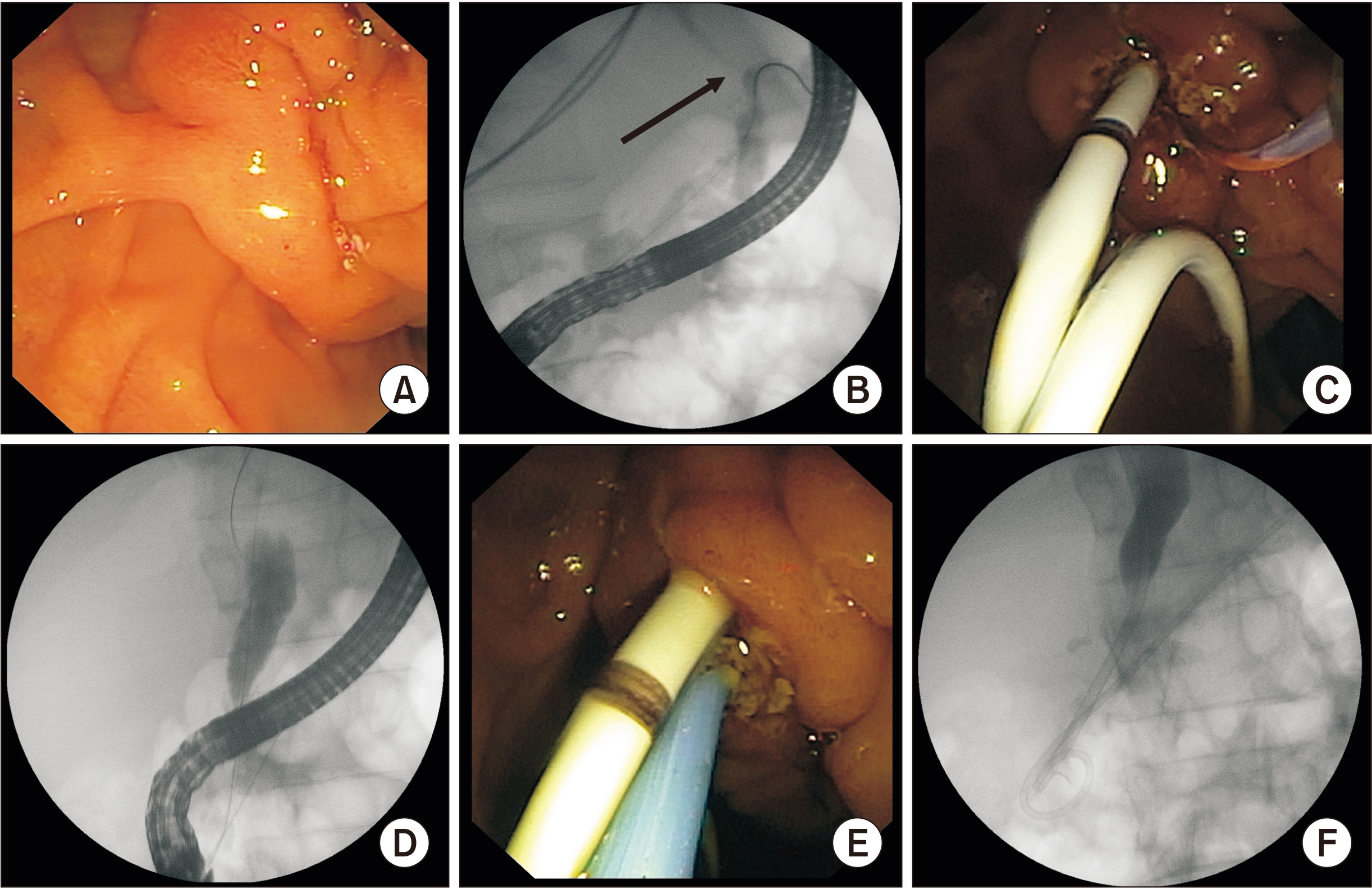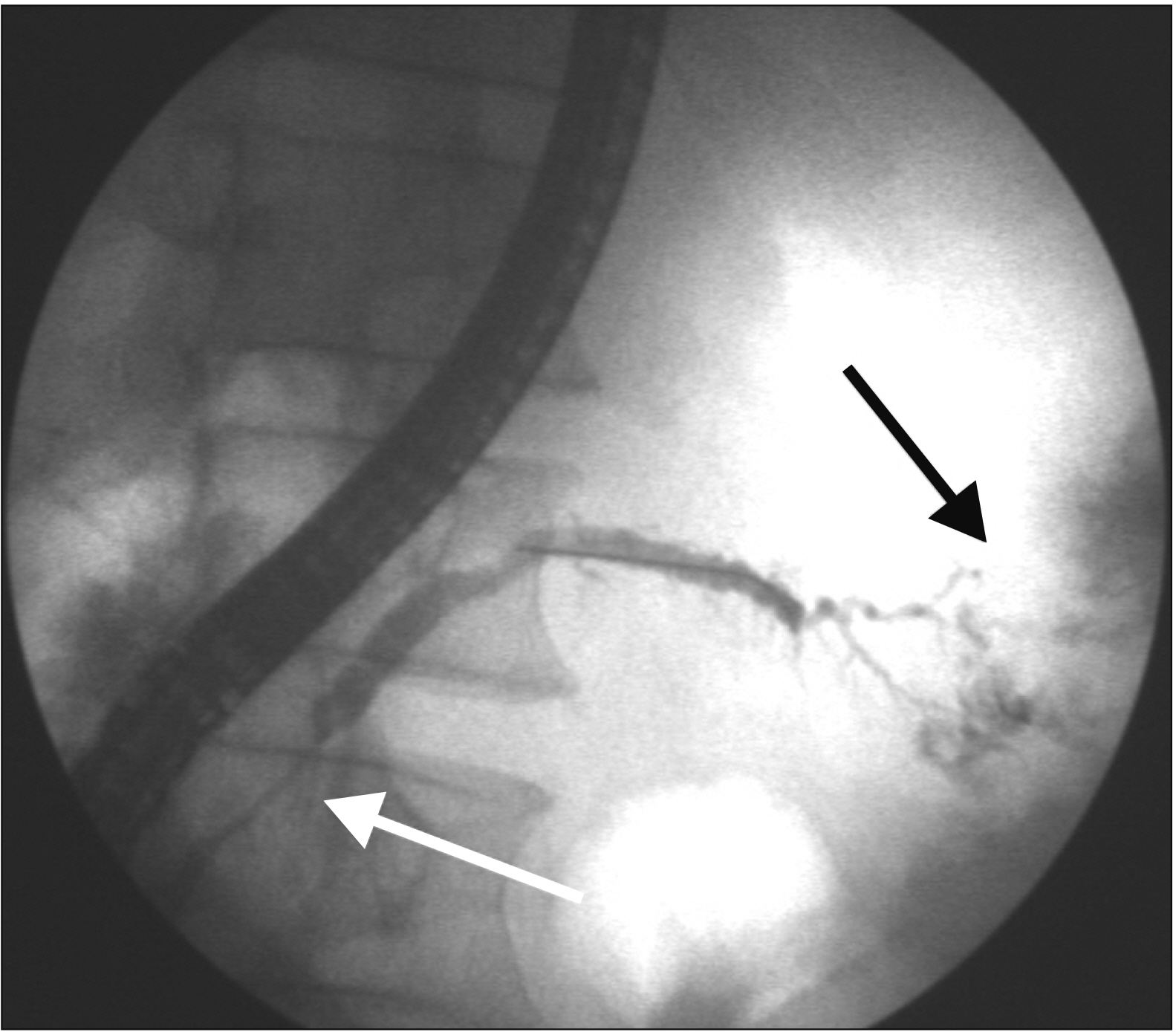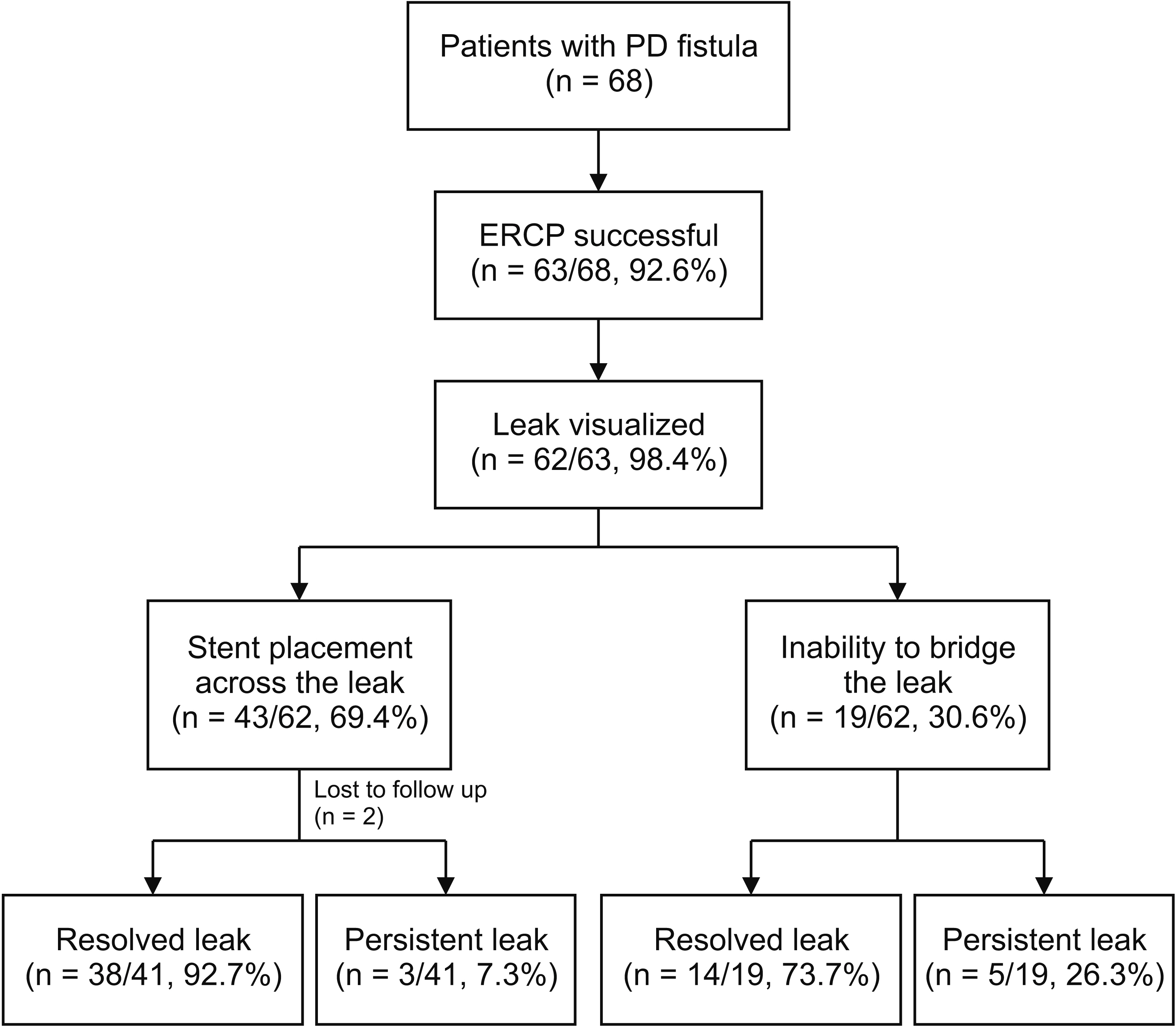Ann Hepatobiliary Pancreat Surg.
2022 Nov;26(4):347-354. 10.14701/ahbps.22-002.
Outcomes and predictors of response to endotherapy in pancreatic ductal disruptions with refractory internal and high-output external fistulae
- Affiliations
-
- 1Department of Gastroenterology, King Edward Memorial Hospital and Seth Gordhandas Sunderdas Medical College, Mumbai, India
- KMID: 2536385
- DOI: http://doi.org/10.14701/ahbps.22-002
Abstract
- Backgrounds/Aims
Endoscopic retrograde cholangiopancreatography (ERCP) remains the primary treatment for a subset of patients with pancreatic fistulae. The objective of this study was reporting outcomes of ERCP and predictors of resolution in patients with pancreatic fistulae refractory to conservative therapy.
Methods
Retrospective review of patients who underwent ERCP and pancreatic stent placement for pancreatic fistula not responding to medical therapy was performed. Clinical features, laboratory parameters, radiological features and pancreatogram findings were noted. Clinical resolution of fistula was the primary outcome measure.
Results
Sixty-eight patients underwent ERCP for high-output pancreatic fistula (Mean age 34.1 years, 91.1% males, 35/68 chronic pancreatitis, 52.9% alcohol etiology). Internal fistulae (pancreatic ascites, pleural effusion, or pericardial effusion) were seen in 55 (80.9%) patients and external fistula in 13 (19.1%) patients. Technical success for ERCP was 92.6% (63/68). Leak was seen in 98.4% (62/63). The most common leak site was body (69.8%). Multiple leak sites were seen in 23.1%. Pancreatic stricture was found in 36.5%. In 44 (69.4%) patients, stent was placed beyond the site of the leak. Resolution at six weeks was achieved in 76.4% (52/68). On univariate and multivariate analyses, placement of stent beyond site of leak was significantly associated with resolution of high-output fistulae (3/41 [7.3%] vs. 5/19 [26.3%], p = 0.03; odds ratio: 6.5, 95% confidence interval: 1.211–34.94).
Conclusions
In our experience, ERCP was successful in 76% of patients with pancreatic fistulae refractory to conservative therapy. Stent placement beyond the site of leak was associated with higher resolution of fistulae.
Keyword
Figure
Reference
-
1. Morgan KA, Adams DB. 2007; Management of internal and external pancreatic fistulas. Surg Clin North Am. 87:1503–1513. xDOI: 10.1016/j.suc.2007.08.008. PMID: 18053844.2. Larsen M, Kozarek R. 2014; Management of pancreatic ductal leaks and fistulae. J Gastroenterol Hepatol. 29:1360–1370. DOI: 10.1111/jgh.12574. PMID: 24650171.3. Adams DB, inivasan A Sr. 2000; Failure of percutaneous catheter drainage of pancreatic pseudocyst. Am Surg. 66:256–261.4. Saadia R. Holzheimer RG, Mannick JA, editors. Fistulas of the pancreas. Surgical treatment: evidence-based and problem-oriented. Munich: Zuckschwerdt;2001.5. Mutignani M, Dokas S, Tringali A, Forti E, Pugliese F, Cintolo M, et al. 2017; Pancreatic leaks and fistulae: an endoscopy-oriented classification. Dig Dis Sci. 62:2648–2657. DOI: 10.1007/s10620-017-4697-5. PMID: 28780610.6. Varadarajulu S, Rana SS, Bhasin DK. 2013; Endoscopic therapy for pancreatic duct leaks and disruptions. Gastrointest Endosc Clin N Am. 23:863–892. DOI: 10.1016/j.giec.2013.06.008. PMID: 24079795.7. Rana SS, Sharma R, Kang M, Gupta R. 2020; Natural course of low output external pancreatic fistula in patients with disconnected pancreatic duct syndrome following acute necrotising pancreatitis. Pancreatology. 20:177–181. DOI: 10.1016/j.pan.2019.12.011. PMID: 31870803.8. O'Toole D, Vullierme MP, Ponsot P, Maire F, Calmels V, Hentic O, et al. Diagnosis and management of pancreatic fistulae resulting in pancreatic ascites or pleural effusions in the era of helical CT and magnetic resonance imaging. Gastroenterol Clin Biol. 2007; 31(8-9 Pt 1):686–693. DOI: 10.1016/S0399-8320(07)91918-1. PMID: 17925768.9. Akisik MF, Sandrasegaran K, Aisen AA, Maglinte DD, Sherman S, Lehman GA. 2006; Dynamic secretin-enhanced MR cholangiopancreatography. Radiographics. 26:665–677. DOI: 10.1148/rg.263055077. PMID: 16702446.10. Arvanitakis M, Delhaye M, Bali MA, Matos C, Le Moine O, Devière J. 2007; Endoscopic treatment of external pancreatic fistulas: when draining the main pancreatic duct is not enough. Am J Gastroenterol. 102:516–524. Erratum in: Am J Gastroenterol 2007;102:1141. DOI: 10.1111/j.1572-0241.2006.01014.x. PMID: 17335445.11. Gans SL, van Westreenen HL, Kiewiet JJ, Rauws EA, Gouma DJ, Boermeester MA. 2012; Systematic review and meta-analysis of somatostatin analogues for the treatment of pancreatic fistula. Br J Surg. 99:754–760. DOI: 10.1002/bjs.8709. PMID: 22430616.12. Hesse U, Ysebaert D, de Hemptinne B. 2001; Role of somatostatin-14 and its analogues in the management of gastrointestinal fistulae: clinical data. Gut. 49(Suppl 4):iv11–iv21. DOI: 10.1136/gut.49.suppl_4.iv11. PMID: 11878789. PMCID: PMC1766896.13. Han X, Xu Z, Cao S, Zhao Y, Wu W. 2017; The effect of somatostatin analogues on postoperative outcomes following pancreatic surgery: a meta-analysis. PLoS One. 12:e0188928. DOI: 10.1371/journal.pone.0188928. PMID: 29211787. PMCID: PMC5718483.14. Zheng H, Qin J, Wang N, Chen W, Huang Q. 2019; An updated systematic review and meta-analysis of the use of octreotide for the prevention of postoperative complications after pancreatic resection. Medicine (Baltimore). 98:e17196. DOI: 10.1097/MD.0000000000017196. PMID: 31567967. PMCID: PMC6756593.15. Baron TH. 2003; Endoscopic drainage of pancreatic fluid collections and pancreatic necrosis. Gastrointest Endosc Clin N Am. 13:743–764. DOI: 10.1016/S1052-5157(03)00100-4. PMID: 14986796.16. Abdallah AA, Krige JE, Bornman PC. 2007; Biliary tract obstruction in chronic pancreatitis. HPB (Oxford). 9:421–428. DOI: 10.1080/13651820701774883. PMID: 18345288. PMCID: PMC2215354.17. Das R, Papachristou GI, Slivka A, Easler JJ, Chennat J, Malin J, et al. 2016; Endotherapy is effective for pancreatic ductal disruption: a dual center experience. Pancreatology. 16:278–283. DOI: 10.1016/j.pan.2015.12.176. PMID: 26774205.18. Gupta S, Gaikwad N, Samarth A, Sawalakhe N, Sankalecha T. 2017; Efficacy of pancreatic endotherapy in pancreatic ascites and pleural effusion. Med Sci (Basel). 5:6. DOI: 10.3390/medsci5020006. PMID: 29099022. PMCID: PMC5635787.19. Telford JJ, Farrell JJ, Saltzman JR, Shields SJ, Banks PA, Lichtenstein DR, et al. 2002; Pancreatic stent placement for duct disruption. Gastrointest Endosc. 56:18–24. DOI: 10.1067/mge.2002.125107. PMID: 12085030.20. Varadarajulu S, Noone TC, Tutuian R, Hawes RH, Cotton PB. 2005; Predictors of outcome in pancreatic duct disruption managed by endoscopic transpapillary stent placement. Gastrointest Endosc. 61:568–575. DOI: 10.1016/S0016-5107(04)02832-9. PMID: 15812410.21. Bakker OJ, van Baal MC, van Santvoort HC, Besselink MG, Poley JW, Heisterkamp J, et al. 2011; Endoscopic transpapillary stenting or conservative treatment for pancreatic fistulas in necrotizing pancreatitis: multicenter series and literature review. Ann Surg. 253:961–967. DOI: 10.1097/SLA.0b013e318212e901. PMID: 21422914.22. Tilara A, Gerdes H, Allen P, Jarnagin W, Kingham P, Fong Y, et al. 2014; Endoscopic ultrasound-guided transmural drainage of postoperative pancreatic collections. J Am Coll Surg. 218:33–40. DOI: 10.1016/j.jamcollsurg.2013.09.001. PMID: 24099888.23. Jürgensen C, Distler M, Arlt A, Brückner S, Ellrichmann M, Matthes K, et al. 2019; EUS-guided drainage in the management of postoperative pancreatic leaks and fistulas (with video). Gastrointest Endosc. 89:311–319.e1. DOI: 10.1016/j.gie.2018.08.046. PMID: 30179609.24. Fujimori N, Osoegawa T, Aso A, Itaba S, Minoda Y, Murakami M, et al. 2021; Efficacy of early endoscopic ultrasound-guided transluminal drainage for postoperative pancreatic fistula. Can J Gastroenterol Hepatol. 2021:6691705. DOI: 10.1155/2021/6691705. PMID: 33564656. PMCID: PMC7850853.25. Kawaguchi Y, Lin JC, Kawashima Y, Maruno A, Ito H, Ogawa M, et al. 2015; Risk factors for migration, fracture, and dislocation of pancreatic stents. Gastroenterol Res Pract. 2015:365457. DOI: 10.1155/2015/365457. PMID: 25945085. PMCID: PMC4402177.
- Full Text Links
- Actions
-
Cited
- CITED
-
- Close
- Share
- Similar articles
-
- A Case of Pancreatic Duct-Portal Vein Fistulae in Pancreatic Cancer
- Endoscopic Management of Benign Pancreatic Stricture Associated with Chronic Pancreatitis
- Endoscopic Management of Pancreatobiliary Stricture in Chronic Pancreatitis
- Pancreatic Exocrine Function according to Pancreatograms in Patients with Chronic Pancreatitis
- Management of Pancreatic Calculi: An Update






